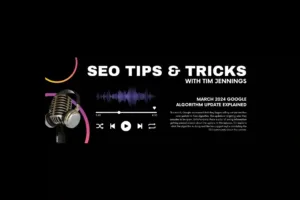A GUIDE TO DOFOLLOW AND NOFOLLOW LINKS FOR SEO
In the world of SEO, there are two types of links that are often discussed: nofollow and dofollow links. A dofollow link is a type of link that allows search engine crawlers to follow it from one website to another and pass on link equity, which can positively impact search engine rankings. On the other hand, a nofollow link is a link that includes a “rel=’nofollow'” tag in its HTML code, which instructs search engine crawlers not to follow that link and not to pass on link equity.
While dofollow links can be beneficial for improving search engine rankings, it’s important to have a healthy mix of both dofollow and nofollow links. Nofollow links can still be valuable for driving traffic to your website, as well as for building brand awareness and credibility. Additionally, having a natural mix of both types of links can help avoid the appearance of spammy or manipulative linking practices, which can be penalized by search engines. As such, it’s important to be strategic in your linking practices and to focus on creating high-quality content that naturally attracts both types of links.

In this episode of Soulheart’s Search Engine Optimization Tips and Tricks podcast, we will explore dofollow links and nofollow links and provide practical tips on how to use them effectively. Understanding the difference can make or break your SEO efforts. Knowing when to use dofollow and nofollow links is essential for effective SEO. While dofollow links can pass on link equity and improve search engine rankings, it’s important to be strategic in their use.
What to Listen For
- Introduction to Dofollow and Nofollow Links - 0:01
- The Basics of Links - 1:03
- The Impact of Links on SEO Ranking - 2:25
- Formatting Links - 4:12
- Dofollow Links - 6:33
- Nofollow Links - 10:31
- Final Thoughts on Indexable and Nofollow Links - 14:33
Transcript
Introduction
Hello and welcome back to the Search Engine Optimization Tips and Tricks Podcast with Tim Jennings! I am your host, Tim, and I have been the head of SEO at Soulheart for over 8 years. Today, we are going to dive into the world of links and how they influence a website’s ranking on search engines. Specifically, we’ll be discussing the difference between the two most common types of links: dofollow and no-follow links. Please allow me to make a quick disclaimer that I will be using the terms dofollow, crawlable, and indexable interchangeably throughout this episode when talking about dofollow links. Ok, now that we got that out of the way, let’s get started!
The Basics of Links
First, let’s start with the basics. Links are clickable elements that connect one web page to another, allowing users to navigate within a website or between websites. They are essential for navigating the internet and are used by search engines to determine the popularity and authority of a web page.
There are two main types of links: internal links and external links. Internal links connect web pages within the same website domain, while external links point to pages on other websites.
Internal Links: Internal links help with website navigation and improve the user experience by allowing users to easily navigate between pages within the same domain. Internal links can also be used to keep users engaged on a website by suggesting related content that they may be interested in.
External Links: External links provide credibility to your website and contribute to its SEO by showing search engines that your website is linking to high-quality and relevant sources. However, it’s important to use external links sparingly and only link to reputable sources to avoid negative impacts on your website’s SEO.
The Impact of Links on SEO Ranking
Links have an impact on a website’s search engine optimization (SEO) ranking. In general, search engines consider links to be votes of confidence for a web page. The more links a web page receives from other reputable websites, the more likely it is to appear higher in search engine results.
The way I like to think about it is this: Both Internal and External Links have a big impact on a website’s search engine optimization (SEO) ranking, and it’s kind of like a popularity contest! Search engines like Google and Bing consider links to be votes of confidence for a webpage. So, the more links a webpage receives from other reputable websites (or from the pages on your website in the case of internal links), the more popular and trustworthy it appears to search engines. This, in turn, makes it more likely that the webpage will appear higher in search engine results pages, kind of like being voted as prom king or queen!
But wait, not all links are created equal! Just like how getting a vote from a popular, well-respected person can carry much more weight than getting a vote from someone nobody knows, there are different types of links that carry different levels of importance. For example, links from sites that are deemed reputable by search engines such as The New York Times carry more weight than links from random, low-quality websites nobody has ever heard of. So, it’s important to focus on building high-quality links to improve a website’s SEO ranking and rise to the top of the popularity contest!
Formatting Links
Now let’s talk about formatting your links. To properly format links on your website, there are a few things to keep in mind:
The First is Anchor Text: Anchor text is the visible, clickable text in a hyperlink, and it provides context to users and search engines about the page being linked to. The anchor text you choose should be clear, relevant, and descriptive to ensure users know what to expect when they click on the link.
Next, Avoid linking to unrelated pages: When linking to external pages, make sure they’re related to your content to maintain the coherence of your website.
Third, you should focus on the accessibility of Links: Make sure your links work properly by testing them frequently. Broken links can hurt your website’s SEO and lead to a poor user experience.
Additionally, fast and responsive loading of links should have your attention: Ensure that your links don’t slow down the loading speed of your website by optimizing them. This is important for both user experience and SEO.
And Finally, Indexable and No-Follow Links: No-follow links tell search engines not to follow the link, so they won’t get credit for the linked content. No-follow links are useful when linking to external sources that aren’t trusted or authoritative, or when linking to paid content on your website. To create a no-follow link, add the “rel=no-follow” attribute to the HTML of the link. We will dive into this deeper shortly.
On the other hand, indexable, or dofollow, links tell search engines to follow the link, thus giving credit for the linked content. They are used with trusted external sources and for your own internal linking purposes.
So as you can see, there’s a lot to consider when creating links on your website. However, on this episode of the podcast I want to dive into Dofollow Links and No-Follow links specifically. Let’s dive in!
Dofollow Links
To start, let’s talk about dofollow links. Dofollow links, otherwise known as “indexable links” or “crawlable links” are links that search engines follow when crawling a website, counting them as votes of confidence for the destination page. These links tell search engines that the content on the destination page is relevant and authoritative. In other words, dofollow links can directly improve a website’s ranking in search engine results pages.
Dofollow links should be used when a website wants to directly impact its SEO ranking. Dofollow links are seen as endorsements or votes of confidence by search engines, indicating that a website or its content is relevant and authoritative. When a reputable website links to another website, known as external linking, and uses a dofollow link, the linked-to website will receive a boost in its SEO ranking. It’s important to use dofollow links in a natural and diverse manner, avoiding spammy or manipulative strategies that can lead to penalties and a decrease in SEO ranking. Dofollow links should be obtained from relevant and authoritative sources by creating high-quality content that others want to link to.
Example: Let’s say you are reading an article about the best coffee shops in New York City. The article links to a specific coffee shop’s website. If that link is a dofollow link, search engines will see it as a vote of confidence for that coffee shop’s website. Therefore, the coffee shop website may appear higher in search results for keywords related to coffee or coffee shops in New York City.
However, your crawlable links aren’t exclusively used for External linking purposes. They are incredibly important for linking content on your own website to other pieces of content on the same site. When a link points to another piece of content on the same website those links are known as internal links and the vast majority of the time should be designated as indexable links.
Using dofollow links for internal linking purposes is a strategy that can help boost a website’s SEO ranking. By adding a crawlable link from one page to another within the same domain, you’re signaling to search engines that the linked-to page has valuable and relevant content. This can help boost the page’s authority and improve its chances of ranking higher in search engine results pages.
Using dofollow internal links can also help keep users engaged on a website by suggesting related content that is relevant to their interests. For example, if a user is reading a blog post about a particular topic, internal links within the post can direct the user to other related posts on the website. This can increase the time users spend on the website and reduce bounce rates, which are factors that are considered by search engines when calculating a website’s SEO ranking.
However, it’s important to use indexable internal links in a natural and appropriate manner. Don’t overdo it by stuffing too many internal links into your content. Instead, choose relevant, high-quality pages to link to and use anchor text that accurately describes the linked-to page. By doing so, you’ll be improving the user experience and boosting your website’s SEO ranking in a natural and organic way.
No-Follow Links
Now let’s discuss the lesser-known sister of the DoFollow Links: No-Follow. No-follow links are links that tell search engines not to follow them when crawling a website. As a result, no-follow links are generally not counted as votes of confidence for the destination page. However, they still have value for website owners and users because they can drive traffic to the destination page.
Example: If you visit a blogging website like Medium, you might notice that all the external links included in the articles are no-follow links. This is because Medium wants to avoid endorsing these external pages, but still provide value to their readers by including links to additional resources or sources of information. These no-follow links can still drive traffic to external pages, even if they don’t directly impact a website’s SEO ranking.
No-follow links should be used when a user wants to link to a page but doesn’t want to pass on any authority or endorsement to that page. For example, if a user is linking to a low-quality or spammy website, using a no-follow link can prevent search engines from associating their website with that low-quality or spammy content.
Another great use-case for no-follow links would be when you are left with no other option but to link to a competitor.
No-follow links can also be used when linking to paid content or sponsored posts. Search engines may penalize a website if it’s discovered that it’s using dofollow links to link to paid content without disclosing that it’s a sponsored post.
In addition, social media links and other third-party user-generated content should generally be set to no-follow. This is because a website cannot guarantee that the content of these links is legitimate or authoritative. Using no-follow links helps prevent spammy comments and user-generated content from impacting a website’s SEO ranking negatively.
Sometimes, you may find yourself in a situation where you need to link to a competitor’s website, but you don’t necessarily want to pass on any search engine ranking value to them. In this case, using a no-follow link is the way to go!
Here’s an example: Let’s say you’re running a pizza restaurant and you want to write a blog post about how to make the perfect margherita pizza. You search for recipes online and stumble upon a recipe from a competitor’s website that you really like and want to share with your readers. Of course, you don’t want to give your competition a boost in their SEO ranking by linking to their page with a dofollow link. So instead, you can use a no-follow link, which will prevent search engines from associating your website with your competitor’s page, but still allow you to provide value to your readers by sharing a great recipe.
In summary, no-follow links should be used when linking to low-quality or spammy content, when linking to a competitor, when linking to paid content or sponsored posts, and when linking to third-party user-generated content. It’s important to use these links in a natural and appropriate manner and to provide value to users of the website.
Final Thoughts on Indexable Links
To sum it up, dofollow or indexable links can directly impact a website’s search engine ranking by telling search engines that the linked-to content is valuable and authoritative. No-follow links may not directly influence SEO ranking, but they can still drive traffic to a website and provide value to users.
That’s it for today’s episode of the Search Engine Optimization Tips and Tricks Podcast with Tim Jennings. Thanks for listening, and we hope you found it informative and engaging. Before I leave, I want to remind you of two things I am very excited about! The first is I produce bonus content based on each episode that you can find by going to soulheart.co/seo and filling out the form and 2. We have a BRAND NEW marketing community launching soon. I know you’re interested in leveling up your digital marketing game and expanding your knowledge with the latest industry trends and rubbing shoulders with some of our own team of expert practitioners here at Soulheart, so get on the waiting list now. Marketing is what powers growth, but not all marketing is equal. Join the waitlist at soulheart.co/seo to access this community and learn the best marketing strategies that exist and that you can start implementing today.
Thanks for listening!
Episode Resources
Get Help With Your SEO Efforts
Whether you’re performing a website overhaul, creating new content, or looking to boost your overall SEO, Soulheart has the SEO tools and expertise to help you. We’d love to learn how we can help you reach your marketing goals this year! Just sign up below to book a chat with us.





